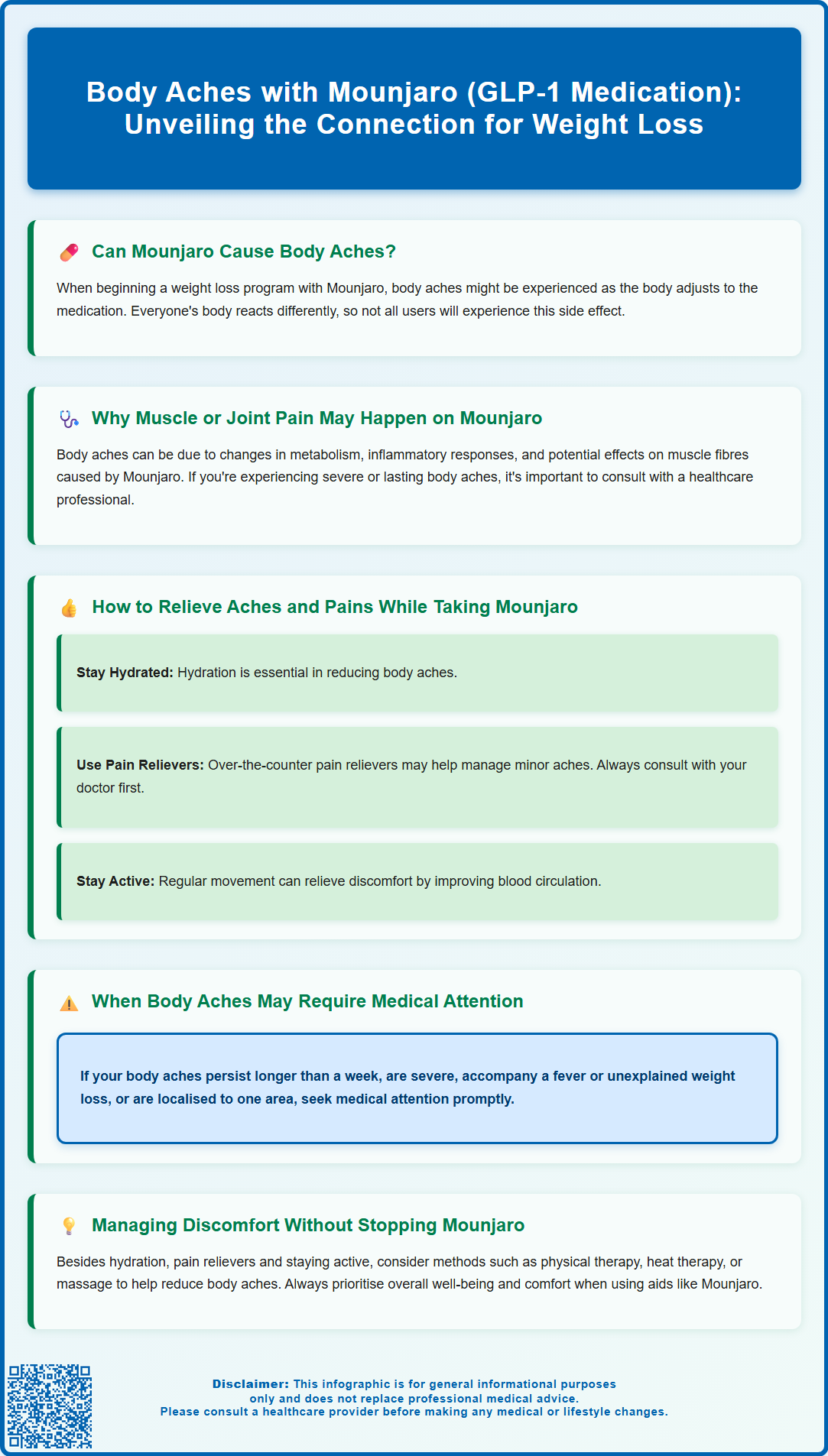
Are you determined to win the battle against weight loss using GLP-1 medications like Mounjaro, but concerned about potential body aches? Well, this article, presented by Bolt Pharmacy, demystifies the connection between GLP-1 treatments and body aches. Let's dive into some enlightening insights about how this medicine, renowned for supporting metabolism and weight control, can sometimes contribute to discomfort—but more importantly, how you can overcome it. Ready to equip yourself with knowledge that's both empowering and effective?
Summary: Yes, Mounjaro, a GLP-1 medication used in weight loss programmes, can cause body aches as a side effect.
Mounjaro (tirzepatide) is a prescription medicine licensed in the UK for the treatment of type 2 diabetes mellitus in adults. It belongs to a class of medications known as dual glucose-dependent insulinotropic polypeptide (GIP) and glucagon-like peptide-1 (GLP-1) receptor agonists. Mounjaro works by mimicking the action of naturally occurring hormones that help regulate blood sugar levels, enhance insulin secretion when glucose is elevated, reduce glucagon release during hyperglycaemia, and slow gastric emptying. This mechanism contributes to improved glycaemic control and, in many patients, weight reduction.
As with all medications, Mounjaro can cause side effects, though not everyone will experience them. According to the MHRA-approved Summary of Product Characteristics (SmPC), the most commonly reported adverse effects include gastrointestinal symptoms such as nausea, vomiting, diarrhoea, constipation, abdominal pain, and reduced appetite. These effects are typically most pronounced when starting treatment or increasing the dose, and often diminish over time as the body adjusts to the medication.
Other side effects documented in clinical trials include injection site reactions, fatigue, headache, and dizziness. Some patients report generalised aches or muscle discomfort; dehydration or electrolyte imbalance from GI side-effects may contribute. Some patients have reported experiencing generalised aches, muscle discomfort, or joint pain during treatment. Understanding the full spectrum of potential reactions helps patients and healthcare professionals distinguish between expected medication effects, coincidental symptoms, and signs requiring further investigation.

The relationship between Mounjaro and body aches is not fully established in clinical literature, and there is no official direct link confirmed by regulatory authorities. However, several hypothetical mechanisms may explain why some individuals experience musculoskeletal discomfort during treatment.
Metabolic changes associated with improved glucose control and weight loss may potentially contribute to body aches. As Mounjaro promotes weight reduction—often a desired therapeutic outcome—the body undergoes significant metabolic adjustments. Clinical studies of tirzepatide have shown that weight loss includes both fat and lean mass reduction, which might theoretically cause muscle adaptation or discomfort in some individuals. Additionally, changes in fluid balance during the initial treatment phase might affect muscle function.
Gastrointestinal side effects such as nausea, vomiting, and diarrhoea can lead to dehydration and electrolyte imbalances, particularly if fluid intake is inadequate. The MHRA SmPC specifically warns about the risk of dehydration with tirzepatide. Dehydration is a well-recognised cause of muscle aches, cramps, and generalised body discomfort. Furthermore, reduced food intake due to appetite suppression may result in inadequate nutrition, including insufficient protein, vitamins, and minerals essential for muscle health.
Inflammatory or immune-mediated responses represent another theoretical consideration, though there is limited evidence for this mechanism. Some patients may experience mild systemic reactions as their body adjusts to the medication. Additionally, the physical act of subcutaneous injection, whilst typically well-tolerated, can occasionally cause localised discomfort that patients perceive more broadly.
It is important to note that body aches during Mounjaro treatment may be coincidental rather than causally related. Many factors unrelated to the medication—such as viral infections, overexertion, stress, or pre-existing musculoskeletal conditions—can produce similar symptoms.
If you experience body aches whilst taking Mounjaro, several practical self-care measures may help alleviate discomfort:
Maintain adequate hydration: Drink plenty of water throughout the day, particularly if you are experiencing gastrointestinal side effects. The NHS recommends 6-8 glasses (about 1.5 to 2 litres) of fluid daily, unless advised otherwise by your healthcare provider. Proper hydration supports muscle function and may reduce cramping and generalised aches.
Ensure balanced nutrition: Despite reduced appetite, consume regular, nutritious meals containing adequate protein, vitamins, and minerals. Protein is essential for maintaining muscle mass during weight loss. Include foods rich in magnesium, potassium, and calcium, which support muscle function. If eating full meals is challenging, consider smaller, frequent portions.
Gentle physical activity: Light exercise such as walking, stretching, or swimming can improve circulation, reduce muscle stiffness, and alleviate discomfort. Avoid sudden increases in exercise intensity, which might exacerbate muscle soreness. Gradually build activity levels as tolerated.
Over-the-counter pain relief: Simple analgesics such as paracetamol may provide symptomatic relief for mild to moderate body aches. Always follow dosing instructions and consult your pharmacist if you have questions about appropriate pain relief options. Non-steroidal anti-inflammatory drugs (NSAIDs) such as ibuprofen may also be considered, but should be used with caution, particularly if you have kidney disease, heart failure, stomach ulcers, are taking blood thinners, or are dehydrated. Discuss with your GP or pharmacist first.
Rest and recovery: Ensure adequate sleep and allow your body time to adjust to the medication. Fatigue can amplify the perception of discomfort, so prioritising rest is important.
Monitor injection technique: Rotate injection sites as recommended to minimise localised reactions. Ensure proper injection technique by following the instructions provided with your medication or consulting your diabetes specialist nurse.
If gastrointestinal side effects or body aches are significant, your healthcare provider may recommend delaying dose increases or temporarily returning to a lower dose, as advised in the Mounjaro SmPC. If body aches persist despite these measures, or if they significantly impact your daily activities, contact your GP or diabetes care team for further assessment and guidance.
You can report any suspected side effects to the MHRA through the Yellow Card Scheme at yellowcard.mhra.gov.uk.
Whilst mild body aches may resolve with self-care measures, certain symptoms warrant prompt medical evaluation. You should contact your GP or healthcare provider if:
Severe or worsening pain that does not improve with simple analgesia or interferes significantly with daily activities
Persistent symptoms lasting more than one to two weeks without improvement
Muscle weakness or difficulty performing routine tasks such as climbing stairs or lifting objects
Joint swelling, redness, or warmth, which may indicate inflammatory arthritis or infection
Fever or signs of infection accompanying body aches, such as chills, sweating, or feeling generally unwell
Dark-coloured urine or reduced urine output, which could suggest dehydration or, rarely, rhabdomyolysis (muscle breakdown)
Chest pain, shortness of breath, or palpitations, which require urgent assessment to exclude cardiac causes
Severe right upper abdominal pain, fever, or yellowing of the skin/eyes, which may indicate gallbladder disease (a recognised risk with GLP-1 receptor agonists and rapid weight loss)
New or worsening visual symptoms if you have pre-existing diabetic retinopathy, as rapid improvement in blood glucose can sometimes temporarily worsen retinopathy
Seek immediate medical attention (call 999 or attend A&E) if you experience:
Severe abdominal pain, particularly if accompanied by persistent vomiting, which may indicate pancreatitis—a rare but serious side effect of GLP-1 receptor agonists
Signs of severe allergic reaction (anaphylaxis), including difficulty breathing, facial swelling, or widespread rash
Symptoms of severe dehydration, such as confusion, dizziness, rapid heartbeat, or inability to keep fluids down
Your healthcare provider may wish to review your medication regimen, assess for potential drug interactions, check blood tests (including kidney function, electrolytes, and creatine kinase if muscle breakdown is suspected), and determine whether dose adjustment or alternative treatment is appropriate. Never stop taking Mounjaro abruptly without medical guidance, as this may affect your diabetes control. Open communication with your diabetes care team ensures safe, effective management of both your condition and any side effects you experience.
When experiencing body aches whilst taking Mounjaro, it is essential to consider alternative causes that may be unrelated to the medication itself. A thorough evaluation helps ensure appropriate management and avoids incorrectly attributing symptoms to the drug.
Viral infections are among the most common causes of generalised body aches. Conditions such as influenza, COVID-19, or other respiratory viruses frequently present with myalgia (muscle pain), fatigue, and malaise. If body aches are accompanied by fever, cough, sore throat, or other infectious symptoms, a viral illness is likely responsible.
Musculoskeletal conditions including fibromyalgia, polymyalgia rheumatica, or osteoarthritis may coincidentally flare during Mounjaro treatment. These conditions cause chronic or recurrent pain that may be mistaken for a medication side effect. Similarly, overexertion, poor posture, or recent physical activity can cause delayed-onset muscle soreness.
Other medications you are taking may contribute to body aches. Statins (cholesterol-lowering drugs) are well-known to cause myalgia in some patients, with the MHRA estimating this affects up to 10% of statin users. If you have recently started or changed other medications, discuss this with your GP or pharmacist for a comprehensive medication review, including over-the-counter and herbal preparations.
Thyroid disorders, particularly hypothyroidism, can cause muscle aches, fatigue, and weakness. According to NICE Clinical Knowledge Summaries, these symptoms are common presentations of thyroid dysfunction. If you have not had recent thyroid function tests, your GP may recommend checking these, especially if you have other symptoms such as weight changes, cold intolerance, or dry skin.
Vitamin D deficiency is common in the UK, particularly during winter months, and can cause musculoskeletal pain and weakness. NHS guidance suggests that adults should consider taking a daily supplement containing 10 micrograms (400 IU) of vitamin D during autumn and winter. Your healthcare provider may suggest checking vitamin D levels and recommending supplementation if appropriate.
Psychological factors including stress, anxiety, and depression can manifest as physical symptoms, including body aches and fatigue. The relationship between mental health and physical symptoms is well-established, and addressing psychological wellbeing may improve physical symptoms.
A comprehensive assessment by your healthcare provider, including medical history, physical examination, and appropriate investigations, will help identify the underlying cause of body aches and guide appropriate management, whether related to Mounjaro or another condition entirely.
Yes, Mounjaro can potentially cause body aches as a side effect. This occurs because the medication works throughout your body rather than just your digestive system. As your body adjusts to Mounjaro, you may experience aches similar to what you would feel after an intense workout. If you experience severe or persistent body aches, it's recommended to consult a healthcare professional.
Not everyone who takes Mounjaro will experience body aches. The occurrence of this side effect can vary greatly between individuals, much like how different people can have different reactions to the same food. However, if you are experiencing severe or persistent aches while taking Mounjaro, you should consult a healthcare professional.
There are several strategies to manage body aches while taking Mounjaro. Stay hydrated, use over-the-counter pain relievers as needed and with your doctor's approval, and remain active. Physical therapies, such as heat therapy or massage, can also be beneficial. Persistent or severe body aches should be discussed with a healthcare professional.
The health-related content published on this site is based on credible scientific sources and is periodically reviewed to ensure accuracy and relevance. Although we aim to reflect the most current medical knowledge, the material is meant for general education and awareness only.
The information on this site is not a substitute for professional medical advice. For any health concerns, please speak with a qualified medical professional. By using this information, you acknowledge responsibility for any decisions made and understand we are not liable for any consequences that may result.
Lorem ipsum dolor sit amet, consectetur adipiscing elit, sed do eiusmod tempor incididunt ut labore et dolore magna aliqua. Ut enim ad minim veniam, quis nostrud exercitation ullamco laboris nisi ut aliquip ex ea commodo consequat. Duis aute irure dolor in reprehenderit in voluptate velit esse cillum dolore eu fugiat nulla pariatur.
Block quote
Ordered list
Unordered list
Bold text
Emphasis
Superscript
Subscript